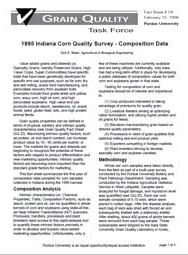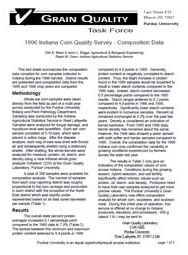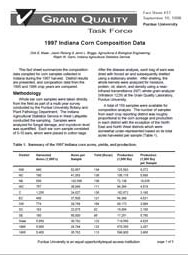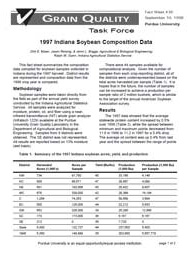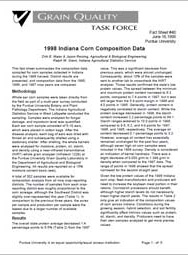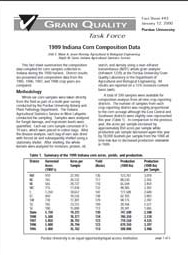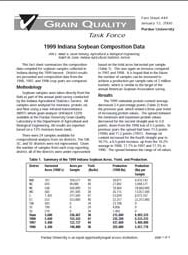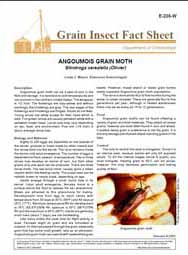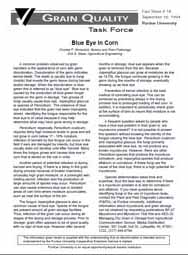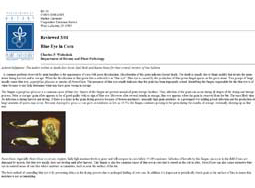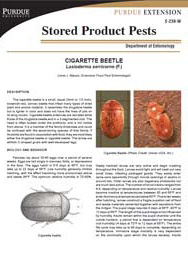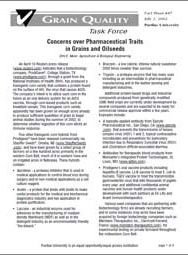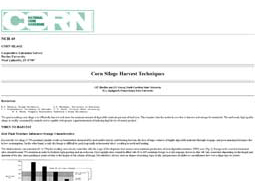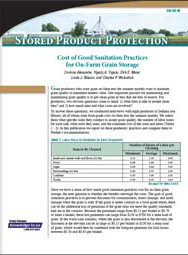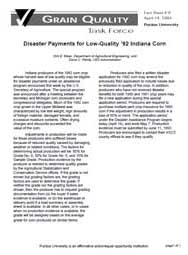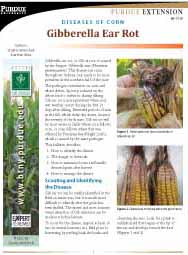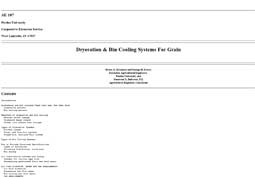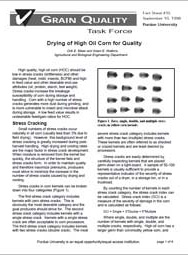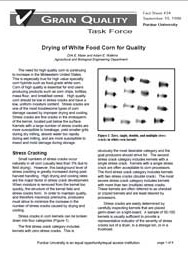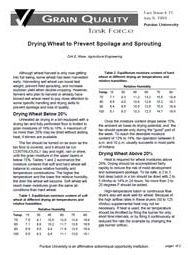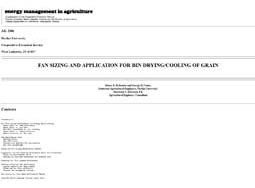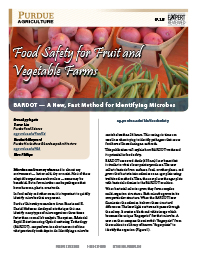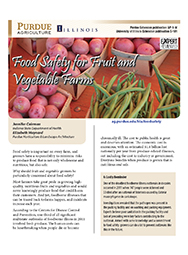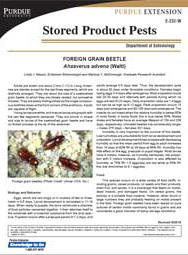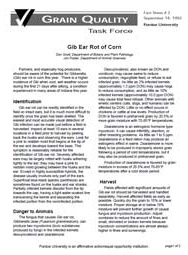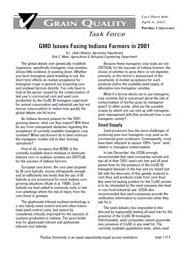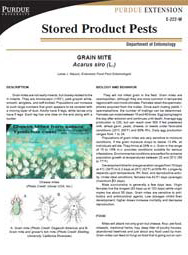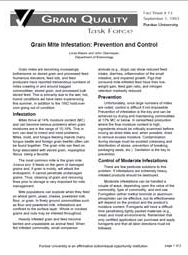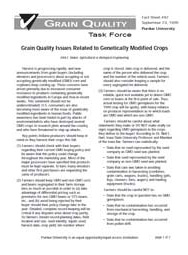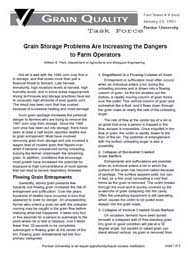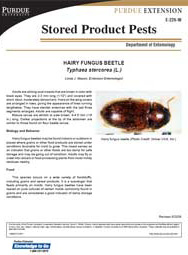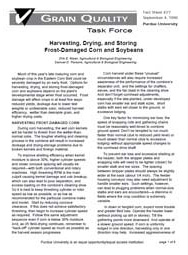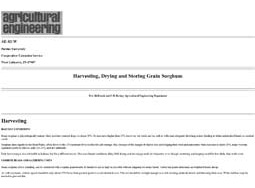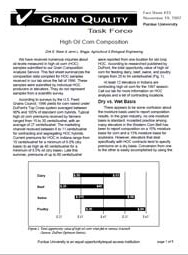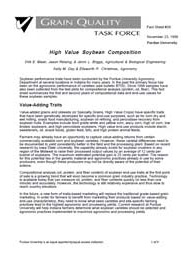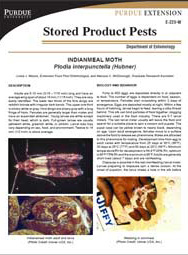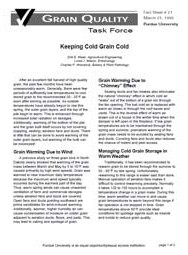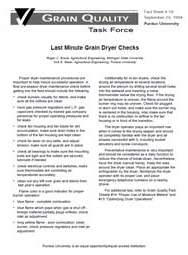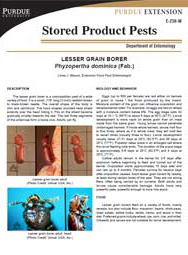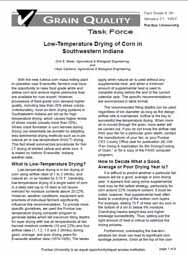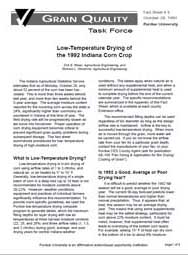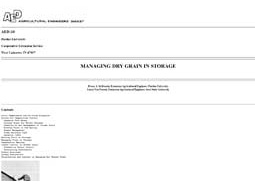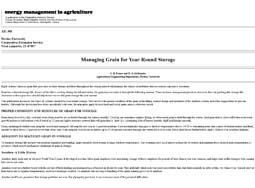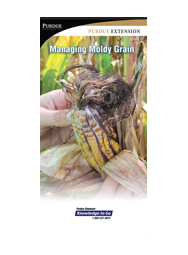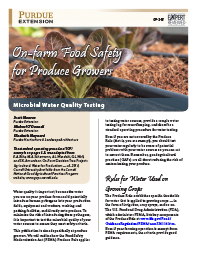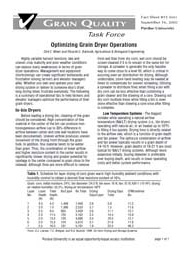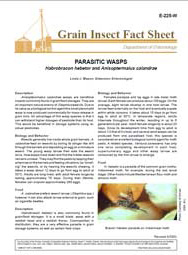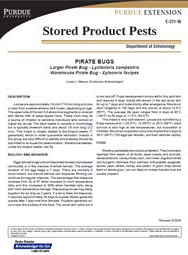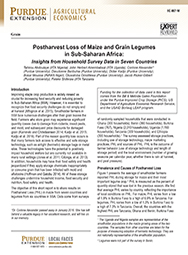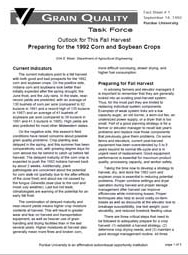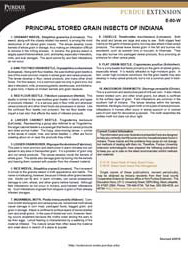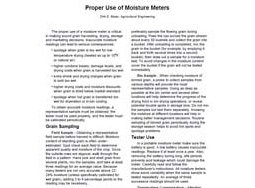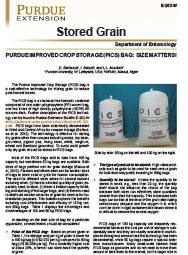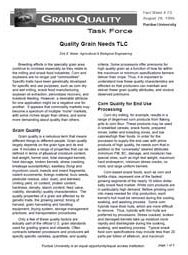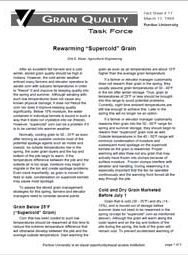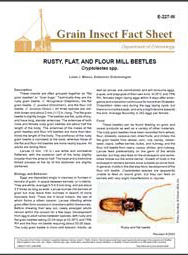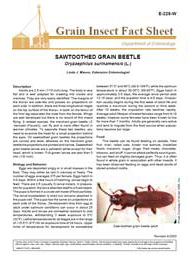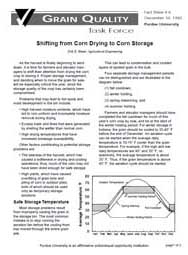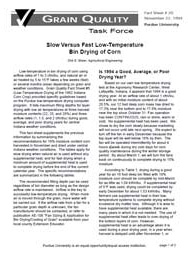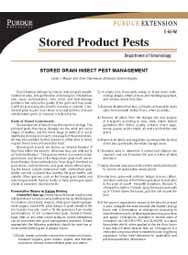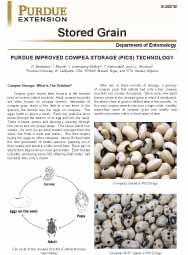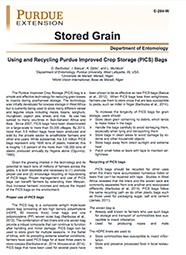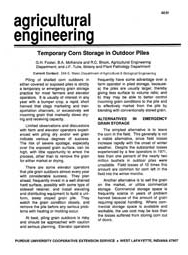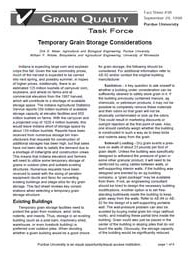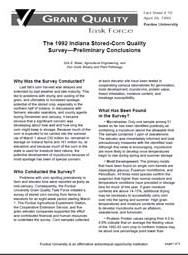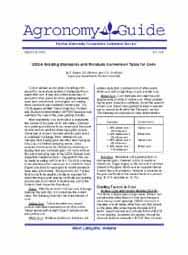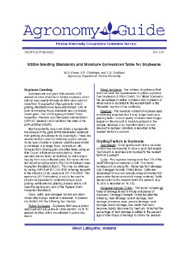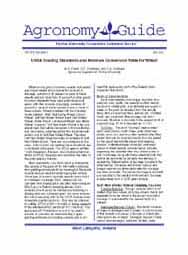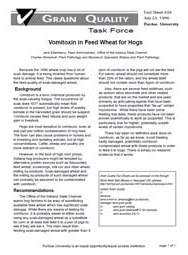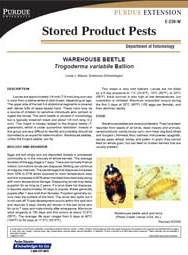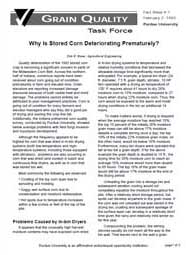Farms & Agribusiness
Post Harvest
1996 Indiana Soybean Composition Data
This two-page publication entitled, "1996 Indiana Soybean Composition Data" discusses specific traits of grains and oilseeds that have been genetically developed for various purposes. Grain quality is defined in terms...
Angoumois grain moth can be a pest of corn in the field and storage. This publication describes this pest and recommends methods for controlling it.
Format: PDF.
Pages: 2.
This one-page publication entitled, "Blue Eye in Corn" discusses a type of germ discoloration. Blue eye in corn is usually due to fungi in the germ tissue. Occuring during harvest, blue eye indicates that grain has be...
This publication discusses fungus that causes blue eye in corn and how to control it. ...
Calculating Grain Weight Shrinkage in Corn Due to Mechanical Drying
This publication describes several popular pencil shrink methods, provides examples of their calculations, and discusses the use of shrinkage as a basis for evaluating custom drying and grain sale alternatives. Tables ...
This publication provides a description of the cigarette beetle. In addition, facts are provided about the biology, behavior and food preferences....
Corn Silage Harvest Techniques
This publication discusses when to harvest, harvest management, and harvest technique. Tables are included listing the influence of corn hybrid maturity group and harvest date on the yield and percent moisture when har...
Cost of Good Sanitation Practices for On-Farm Grain Storage
One key to grain quality is to put clean grain in bins that are free of insects. This 5-page publication explains what it takes to ensure clean bins and how much time and what costs are involved....
Costs of Drying High-Moisture Corn
In a normal year, many farmers like to wait until the moisture content is at least below 28% before beginning harvest. The field moisture content continues to decrease during the fall. This publication shows the approxim...
Disaster Payments for Low-Quality '92 Indiana Corn
This grain quality fact sheet has information about applying for 1992 disaster assistance for low quality corn grown in the Midwest....
Diseases of Corn: Gibberella Ear Rot
Gibberella ear rot, or Gib ear rot, can occur throughout Indiana, but it tends to be more prevalent in the northern half of the state. This publication describes how to recognize and identify the disease, its danger to a...
Dryeration and Bin Cooling Systems For Grain
Deals with the planning, operation and management of dryeration and bin cooling systems on individual farms, as opposed to country and terminal elevator installments....
Drying Soybeans Requires Special Considerations
This two-page publication entitled, "Drying Soybeans Requires Special Considerations" discusses the need to reduce moisture content in soybeans to a safe storage level. Enclosed is a short review of some tips when usi...
Drying Wheat to Prevent Spoilage and Sprouting
This grain quality fact sheet has information about drying wheat below 20% grain moistures, above 20% and airflow considerations....
Ear Corn Drying, Storage and Handling
This three-page publication entitled, "Ear Corn Drying, Storage and Handling" uses a fact sheet to summarize items such as naturally ventilated ear corn cribs. Natural and heated air drying and fan selection and airfl...
Fan Sizing and Application for Bin Drying/Cooling of Grain
Presents data and tables for determining the air flow, system performance and energy relationships in bin drying and cooling....
Food Safety for Fruit and Vegetable Farms: BARDOT - A New, Fast Method for Identifying Microbes
In food safety and other areas, it is important to quickly identify microbes that are present. Purdue researchers developed a technique that can identify many types of microorganisms three times faster than normal lab...
Food Safety for Fruit and Vegetable Farms: Good Agricultural Practices for Fruit and Vegetable Farms
Food safety is important on every farm, and growers have a responsibility to minimize food safety risks to produce food that is not only wholesome and nutritious, but also safe. This joint publication of Purdue Extension...
Food Safety for Fruit and Vegetable Farms: Good Agricultural Practices for Fruit and Vegetable Farms
Food safety is important on every farm, and growers have a responsibility to minimize food safety risks to produce food that is not only wholesome and nutritious, but also safe. This joint publication of Purdue Extension...
This publication provides a description of the foreign grain beetle, an insect pest that feeds on molds. In addition, facts are provided about the biology, behavior and food preferences of the beetle....
This grain quality fact sheet has information about identifying Gib ear rot, its danger to animals, and its effects on harvest and storage....
This publication provides a description of grain mites. In addition, facts are provided about the biology, behavior, food preferences and control methods for grain mites....
Grain Mite Infestation: Prevention and Control
This grain quality fact sheet has information about infestation, prevention, and control of moderate infestation of grain mites....
Grain Storage Problems Are Increasing the Dangers to Farm Operators
This grain quality fact sheet explains flowing grain entrapments, four primary accident categories, and offers tips to protect you from entrapment and suffocation. It also discusses respiratory hazards, how to reduce...
This publication provides a description of the hairy fungus beetle, a pest of grain that feeds on mold. In addition, facts are provided about the biology, behavior and food preferences of the beetle....
Harvesting, Drying, and Storing Frost-Damaged Corn and Soybeans
This eight-page publication entitled, "Harvesting, Drying, and Storing Frost-Damaged Corn and Soybeans" discusses frost damage. How far along the plant was when frost occurred reflects on how best to treat the corn and...
Harvesting, Drying, and Storing Grain Sorghum
This five-page publication provides information on three topics: harvesting, threshing and drying. The harvesting chapter includes information on harvest conditions, combine heads and gathering units. The threshing chapt...
This publication provides a description of the Indianmeal moth. In addition, facts are provided about the biology, behavior and food preferences of the Indianmeal moth....
This two-page publication entitled, "Keeping Corn Grain Cold" covers ways to minimize the warming of the grain layers. Three topics covered include: grain warming due to wind, grain warming due to the "chimney" effe...
Last Minute Grain Dryer Checks
This one-page publication entitled, "Last Minute Grain Dryer Checks" gives a list of proper grain dryer maintenance procedures. A final pre-season dryer check should include checking the burners, fan housing, wear on ...
The lesser grain borer is a pest that feeds on a variety of food. This publication provides a description and discusses its biology and behavior and the types of food it feeds on....
Low-Temperature Drying of Corn in Southwestern Indiana
This nine-page publication entitled, "Low-Temperature Drying of Corn In Southwestern Indiana" discusses a variety of topics. Low temperature drying, how to maximize capacity, recommendations, and tables are also covere...
Low-Temperature Drying of the 1992 Indiana Corn Crop
This grain quality fact sheet explains low-temperature drying and how to maximize the capacity of low-temperature drying systems. It also has an appendix that discusses how to use the recommendations, and includes ex...
Managing Aspergillus Ear Rot and Aflatoxin
This brochure offers quick tips to help grain producers, livestock producers, and storage and handling personnel minimize the risk posed by aflatoxin. Additional information is available on the Managing Moldy Corn websi...
This publication covers maintaining quality of dry grain in storage. Causes of grain spoilage, its prevention, insect control, and personal safety are also addressed in the publication....
Molds are a concern because they can reduce grain quality and storability. Under some conditions, certain molds can produce mycotoxins, substances that can be harmful to livestock and humans. This brochure explains basic...
Mycotoxins and Mycotoxin Test Kits
This publication discusses mycotoxins, aflatoxin, deoxynivalenol, zearalenone fumonisin, sampling, and mycotoxin analysis kits. Illustrations are provided showing a neogen test kit and vicam test kit. ...
On-farm Food Safety for Produce Growers: Microbial Water Quality testing
Water quality is important, because the water you use on your produce farm could potentially introduce human pathogens into your production fields, equipment and workers, washing and packing facilities, and directly o...
Optimizing Grain Dryer Operations
This four-page publication entitled, "Optimizing Dryer Operations" discusses some ways of correcting the weaknesses of dryer operations. High harvest moisture and poor weather conditions contributed to longer drying t...
This publication provides a description of parasitic wasps. Parasitic wasps are beneficial insects commonly found in grain/food storages. The publication provides facts about the biology, behavior and food preferences of...
This fact sheet provides information about pirate bugs. The sheet includes information on the biology, behavior and food preferences of these bugs....
Postharvest Loss of Maize and Grain Legumes in Sub-Saharan Africa
In Sub-Saharan Africa, food security challenges do not end at harvest. Nine Purdue University researchers studied seven countries and concluded that smallholder farmers need greater access to effective storage technologi...
Preparing for the 1992 Corn and Soybean Crops
This grain quality fact sheet has information about preparing for fall harvest, including establishing a harvest strategy, determining crop drying needs, and maintaining a good storage management routine....
Principal Stored Grain Insects of Indiana
Gives picture and general description of ten common stored grain insect pests of Indiana. ...
This two-page publication entitled, "Proper Use of Moisture Meters" deals with grain sampling, tester use, and calibrating for accuracy. Reading moisture output properly is necessary and can lead to serious problems i...
Purdue Improved Crop Storage (PICS) Bag: Size Matters!
The Purdue Improved Crop Storage (PICS) bag is a cost-effective technology for storing grain to reduce post-harvest losses. Most of the PICS bags sold to date have 100 kg capacity but sometimes the 50 kg bags are availab...
Purdue Improved Crop Storage (PICS) bags 25KG (100 Bags) - SHIPPING TBD
**IMPORTANT; PLEASE READ PRIOR TO ORDERING - Due to varying costs based on shipping location, the shipping fees for this item will be determined on an individual basis. Shipping totals include the ACTUAL shipping amou...
Purdue Improved Crop Storage (PICS) bags 25KG (20 Bags) - SHIPPING TBD
**IMPORTANT; PLEASE READ PRIOR TO ORDERING - Due to varying costs based on shipping location, the shipping fees for this item will be determined on an individual basis. Shipping totals include the ACTUAL shipping amou...
Purdue Improved Crop Storage (PICS) bags 25KG (5 Bags) - SHIPPING TBD
**IMPORTANT; PLEASE READ PRIOR TO ORDERING - Due to varying costs based on shipping location, the shipping fees for this item will be determined on an individual basis. Shipping totals include the ACTUAL shipping amou...
Purdue Improved Crop Storage (PICS) bags 25KG (50 Bags) - SHIPPING TBD
**IMPORTANT; PLEASE READ PRIOR TO ORDERING - Due to varying costs based on shipping location, the shipping fees for this item will be determined on an individual basis. Shipping totals include the ACTUAL shipping amou...
Purdue Improved Crop Storage (PICS) bags 50kg (100 Bags) - SHIPPING TBD
**IMPORTANT; PLEASE READ PRIOR TO ORDERING - Due to varying costs based on shipping location, the shipping fees for this item will be determined on an individual basis. Shipping totals include the ACTUAL shipping amou...
Purdue Improved Crop Storage (PICS) bags 50kg (20 Bags) - SHIPPING TBD
**IMPORTANT; PLEASE READ PRIOR TO ORDERING - Due to varying costs based on shipping location, the shipping fees for this item will be determined on an individual basis. Shipping totals include the ACTUAL shipping amou...
Purdue Improved Crop Storage (PICS) bags 50kg (5 Bags) - SHIPPING TBD
**IMPORTANT; PLEASE READ PRIOR TO ORDERING - Due to varying costs based on shipping location, the shipping fees for this item will be determined on an individual basis. Shipping totals include the ACTUAL shipping amou...
Purdue Improved Crop Storage (PICS) bags 50kg (50 Bags) - SHIPPING TBD
**IMPORTANT; PLEASE READ PRIOR TO ORDERING - Due to varying costs based on shipping location, the shipping fees for this item will be determined on an individual basis. Shipping totals include the ACTUAL shipping amou...
This three-page publication entitled, "Quality Grain Needs TLC" covers breeding efforts and how they continue to increase. Specific traits have been genetically altered for certain purposes including snack food manuf...
This three-page publication entitled, "Rewarming 'Supercold' Grain" discusses how some farmers attempted to "freeze" corn to improve its keeping quality through spring and summer. To avoid spoilage and mold, it is nec...
Rusty, Flat, and Flour Mill Beetles
This publication provides a description of rusty, flat and flour mill beetles. In addition, facts are provided about the biology, behavior and food preferences of the beetle....
This is a fact sheet that provides information about sawtoothed grain beetles. The sheet includes information on the biology, behavior and food preferences of the beetle....
Shifting from Corn Drying to Corn Storage
This grain quality fact sheet has information about safe storage temperatures, aeration cooling time, turning the fan off and additional management tips....
Slow Versus Fast Low-Temperature Bin Drying of Corn
This two-page publication entitled, "Slow Versus Fast Low-Temperature Bin Drying of Corn" discusses the guidelines and statics on low- and high-temperature in bin drying. This fact sheet provides recommendations for 1...
Stored Grain Insect Pest Management
Explains post-harvest IPM strategies that help maximize grain quality using S.L.A.M. (sanitation, loading, aeration, and monitoring). Provides steps and benefits for each section.
Format: Pamphlet and...
Stored Grain: A Guide on the Use of PICS Bags for Grain Storage
Post-harvest storage losses of grain to insects are at least 30 percent in Sub-Saharan Africa. There are many control methods but most are minimally effective, expensive, not scalable, or present health hazards. The Purd...
Stored Grain: Purdue Improved Cowpea Storage (PICS) Technology
Cowpea grain stored after harvest is the favorite food of insects called bruchids. Adult cowpea bruchids are often known as cowpea weevils. Infestation of cowpea grain starts in the field at a low level.
Forma...
Stored Grain: Using and Recycling Purdue Improved Crop Storage (PICS) Bags
Purdue Improved Crop Storage (PICS) bags have been disseminated on a large-scale throughout West Africa. The bags represent 1,600 tons of plastic material. This publication examines how to properly use and recycle the PI...
Temporary Corn Storage in Outdoor Piles
A seven-page publication giving guidelines for storing corn outdoors. Aeration information and other considerations and precautions presented together with schematics....
The 1992 Indiana Stored-Corn Quality Survey-Preliminary Conclusions
This grain quality fact sheet has the results of a survey conducted by the Grain Quality Task Force in March 1993 to survey stored corn moving from farms to elevators....
USDA Grading Standards and Moisture Conversion Table for Corn
Typical scale of price discounts currently used by local and terminal elevators and processors in Indiana....
USDA Grading Standards and Moisture Conversion Table for Soybeans
This publication provides soybean price discount schedules currently used by local and terminal elevators and processors in Indiana, official USDA grade standards for soybeans, and a moisture conversion table....
USDA Grading Standards and Moisture Conversion Table for Wheat
This publication gives you information relative to wheat storage, marketing, and processing, namely: l. typical elevator price discount schedules, 2. moisture conversion tables, and 3. USDA official grade standards....
Vomitoxin in Feed Wheat for Hogs
This one-page publication entitled, "Vomitoxin in Feed Wheat for Hogs" discusses vomitoxin and how it has caused the 1996 wheat crop to be diverted from human food to animal feed. Vomitoxin causes feed refusal and poo...
This fact sheet provides information on the warehouse beetle. The sheet includes information on the biology, behavior and food preferences of the beetle....
Why Is Stored Corn Deteriorating Prematurely?
This grain quality fact sheet discusses problems caused by in-bin dryers, column dryers, and holding wet corn without drying. It also offers solutions to counteract deteriorating grain and provides important safety p...









